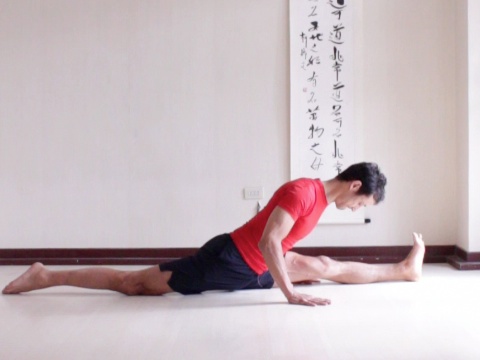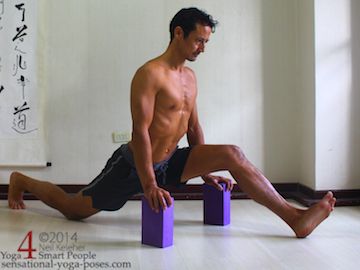Strengthen and Stretch (At the Same Time)
Ideally with the splits you can learn to control your legs so that you can keep them strong as they slide apart.
You then lengthen your leg muscles while keeping them active (I describe this in the splits).
That can be scary and so in the beginning focus on using your arms as follows in the description below.
Create a Stable Foundation
The challenge with hanumanasana is that it is hard to create a stable foundation. Your legs and hips may tighten up if you don't have one and that will prevent you from going deeper.
One solution is to put your hands on blocks so that you can use your arms to help give your body a foundation. You can then use your arms to help support the weight of your upper body. You can then lower your body with control, giving your legs and hips the ability to relax and stay relaxed as you open.
Another option is to hang on to ropes or straps, if your have them. Or if you have a coach or partner, they can help you slowly lower your body into hanumanasana as you hold on to them, perhaps with your hands around their neck for support.
Relax and Lengthen
What happens if you don't use your arms to create a foundation for your hanumanasana?
If you aren't used to doing splits, and particularly if you have notions of it being painful and a potential cause of injury, then your legs will tighten up. They'll do that to prevent you lowering down into splits. They'll tighten up because they are supporting the weight of your body. And so if you place your hands on blocks or hang from ropes, you can pull upwards with your arms, or push downwards, enough to take some of the weight of your body so that your legs can relax. You can then focus on slowly lowering your body with control by using the strength of your arms. At the same time you can focus on first relaxing your legs and then on keeping them relaxed as you slowly lower your pelvis close to the ground.
An additional benefit of doing splits in this way is that it can help increase arm strength.
The arms are only a part of creating a foundation.
Lengthening the Back of Your Front Leg
When doing the splits (or working towards them) one leg is forwards and the other leg is back. In this position the hamstrings of the front leg is lengthened, or needs to in order for the front leg to go forwards.
In general this group of muscles attaches to the pelvis at the sitting bone and to the back of the fibia and tibia (the two bones of each lower leg) just below the knee.
You can create some stability for these muscles by "locking" or stabilizing the pelvis via the spine. If you make the spine rigid by using either the spinal erectors or the abdominals or some combination of both, then you can help to stabilize your pelvis and give your hamstrings a stable foundation so that it is easier to relax them and lengthen them.
Generally, if doing hanumanasana while your body is upright, then bend the spine backwards and keep it bent backwards by using your spinal erectors, the muscles that run up the back of the spine and to either side of it.
Focus on bending your lumbar spine and thoracic spine backwards. You'll feel a contraction along your lower back and the back of your ribcage when the particular muscles that act on these parts are active.
If you are leaning forwards slightly, then in that case you may find that using your abdominals to stabilize your spine and pelvis is more helpful.
Relaxing the Hip Flexors of the Back Leg
With respect to the back leg in hanumanasana, the main muscles that you can focus on relaxing are the iliacus, psoas, and potentially the rectus femoris. These are all hip flexors but the rectus femoris also acts on the knee. Because it is grouped with the quadriceps, it may activate if you straighten your back knee. You may be able to help it to relax if you focus the effort on straightening your back knee to the region of muscle just above your knee caps.
The psoas attaches to your lumbar spine while the iliacus attaches to the inside of your pelvis. As with the hamstrings, if you stabilize your spine (using abs or spinal erectors) then you provide a still point for these muscles, a stable foundation making it easier to relax these muscles and lengthen them.
Create Space In Your Hips and Spine
With the pelvis unified with your spine providing a stable platform, the next element that you can focus on in hanumanasana, is that of creating space within your hip sockets. You can do this by reaching your front thigh forwards and your back thigh backwards. In either case you can actually create a small amount of space between the head of the thigh bone and the hip socket. You may find that this small amount of space, and the reaching sensation that accompanies it, helps you to go deeper.
You can do something similiar with your spine, reach your ribs and head away from your pelvis. Press down with your hands to accentuate this lengthening upwards. Allow your pelvis to sink. Create length and then work at making your spine rigid while you hold the pose.
Gradually Becoming Square in Hanumanasana
So that your hips stay square to your legs you can try using your inner thighs to pull your inner knees to towards you pelvis while continuing to move one foot at a time forwards and backwards.
Do try to point your back knee downwards, but don't be afraid to start with your back knee pointing outwards. You can gradually work at pointing it downwards. If you lift your back knee, try pressing the inner thigh of your back leg upwards even as you sink your pelvis downwards.
Rest On the Floor and Between Sides
Once your hips do touch the floor you'll find it a lot easier to relax because the floor is now your foundation. However, until you reach this point you may find resting your pelvis on a block or several blocks is helpful.
After you do one side, rest for a few moments in kneeling position before doing the other side.
Moving Rhythmically Deeper
Keeping your spine rigid while doing hanumanasana, you can focus on straightening your knees one knee at a time. Do this rhythmically, or if your like, with your breath. With both knees bent, use your arms to lift your torso and reach or press your front foot forwards so that your front knee straightens. Slowly lower, and then bend your front knee when your have to. Repeat smoothly and slowly. Then do the same but this time focus on reaching your back foot away from your pelvis and straightening your back knee. Then try this while trying to reach with both feet at the same time.
Rest (I like to rest in kneeling posture) and then do the other side.
Shape Your Feet
If you do hanumanasana twice on both sides, try it once (on each side) with your back toes tucked under, and then with the top of your back foot flat on the floor. In both instances, try to shape both your front foot and your back foot. With your front foot, press forwards through the front of your foot. Try to shape both your inner and outer arches. With your back foot, if the top of your back foot is on the floor then straighten the inside and outside edges of that ankle and focus on using your leg to press back through the toes of your back foot.
If the toes of your back foot are turned under, work at forming the arches of your back foot and press back through the heel.
Auxiliary actions for Hanumanasana
On various days when I do this posture, certain actions work and then certain actions don't work. Some actions that you can play with include:
- pressing both thighs up (as if instead of your pelvis sinking down, you are trying to lift your legs up, off of the ground)
- pressing both thighs out.
- pressing both thighs in.
The feeling of "pressing the thighs up" is literally that. Rather than hinging the thighs at the hips focus on pressing the entire thigh bone upwards, both the back leg and front.
When pressing the thighs out, the muscle action happens at the outside of the hip near the front (gluteus minimus and tensor fascae latae.) You may find this more helpful when your spinal erectors are active and your spine is either straight or bent backwards. You may find that squeezing your thighs together helps when bending forwards.
With more experience, and again, on some days you'll be in the mood for this, on other days not, you can start with your back knee on the floor and your front knee straight and you can "slide" into the pose with your hands off of the floor. Here instead of relaxing, you are lengthening while said lengthening muscles are still active.
Move slowly and stay "tight" until your pelvis touches the floor. Then because the floor is supporting your pelvis, you'll find that you can relax. You may also find that you feel you need to touch your hands to the floor before your pelvis does. That's fine. With practice you'll be able to do this with greater and greater ease. However, that doesn't mean that you shouldn't pay any less attention while doing this. Always be aware so that you can stop yourself if you are having a "tight" day.
Preparation Poses
So that you can work into hanumanasana a little bit more comfortably, two yoga poses that you can use include high lunge and low lunge. Use high lunge to prepare the back leg in splits and use the low lunge to prepare the front leg.
Published: 2011 01 17




